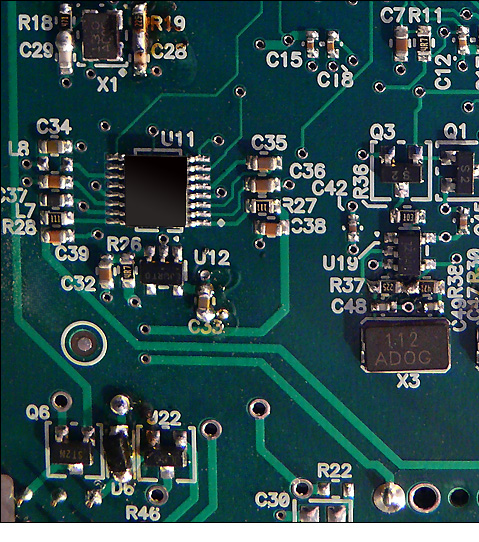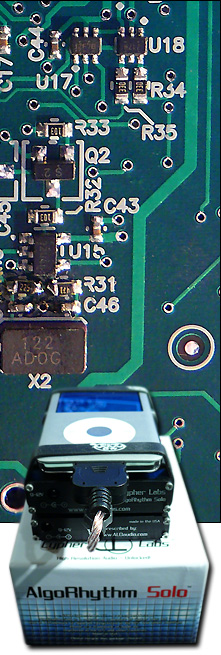This review page is supported in part by the sponsors whose ad banners are displayed below |
 |
 |
Original twin-battery then final production single battery Solo.
|
 |
|
 |
While of identical foot print to the RxMkII, the AlgoRhythm box is a bit thicker/taller because the entirety of its circuit board is peopled with parts and the two batteries later changed to one big one must stack atop rather than float in a cut-out.
|
|
|
Though not as busy as my Onkyo ND-S1 digital-direct docks—which still lack an onboard converter and analog output stage— the Solo seems rather busier than the original Wadia whose internal build left much to be desired.
|
 |
The final stack is quite the brick. Clearly the next Cypher Labs product will combine Solo and amp functionality into one chassis to appeal to lesser extremists. Due to socketry layout, the iPod (iTouch, iPhone) piggybacks rotated by 180°. With the iDevice display facing you, the RxMkII strapped to the Solo will have the volume control sit on top. This inverts directionality. Louder goes left. With the iPod piggybacking just the amp, the volume sits beneath Apple's click wheel while facing the viewer. Now right goes louder.
|
|
|
While somewhat bizarre, certain folks could hope—or worry—that the Solo charges whatever iDevice connects to it. After all, the charge function is often enabled when the 30-pin connection is engaged. Here that's obviously not the case as one battery-powered device charging another would only drain the former's batteries that much quicker.
|
 |
Ken Ball: "I had an interesting observation today. Previously I had—we all did—used hand-soldered 'final proto' versions of the Solo. Later we got four 'golden samples' from the pro plant we hired to make the Solos. It's a local company. David and I literally drove out for a tour of the factory which was awesome. It's all mechanical assembly and very precise. I had not played with these golden samples until today and was very surprised to find that these sound easily 10 to 15% better than our hand-assembled jobs which I'd become accustomed to hearing. Also the production units have a much larger battery pack. Either way it was a noticeable sonic improvement. The loaner you have is a newer automated build of course."
So much for robotic assembly being inferior to hand labor by definition.
|
 |
"Have you tried using a mini to RCA running from the Solo to a big home amp yet? Or S/PDIF to a big DAC? I should have included a good mini-to-RCA link. [I had a good one from Zu for just that purpose - Ed.]
I was using an iPod and Solo in the store yesterday when customers wanted to hear a speaker amp. I was very tickled by how much better it sounded over the early versions and simply getting such damn good results from an iPod. We had a lot of pre-orders come in within a day of the Apple cert announcement. I feel rather glowy after pushing this project hard for two years now and having had so many troubles getting it this far." So much for how easy it is to see a clever idea through from start to finish.
|
 |
| The identity of the 16-legged chip in position U11 is deliberately erased to not give away the cypher. Most of the remaining silicon's writing was either too faded or small to make out. We'll leave the cloning brigade guessing. On practical matters, the included universal charger with exchangeable plug is a nicely tiny thing—about a silver dollar squared—that'll fit snugly into any traveler's audio pack. Even a lady's fashion hand bag won't complain. |
|
 |
|
 |
When my early sample's twin batteries drained after just a few hours of playtime for a full-day charge, I notified Ken. "When charge is complete, the power switch in the off position should blink." Mine wouldn't. "Our engineer indicated that a revision might be required for the blinkage and is looking into it. Lucky for us the charge controller IC is pretty sophisticated. It's easily tweaked with a cap value. Our samples were getting 20 to 24 hours of play but I tried mine last night and noticed too that the charge time to blinking seemed a bit too long. The one you have should be fully charged after 6 or 7 hours. After that try turning it off and then on and see whether it blinks shortly after this." It didn't. "Regardless it should be fully charged and be nothing but an indicator issue." I still got only about 3 hours of play time. "Your sample has definitely crapped out. We've now learnt that 2 x li-ion batteries in tandem are a potential culprit for instability and excessive heat. We're switching to a single larger battery which perhaps we should have done in the first place. Send us your sample back for an autopsy."
|
 |
  |
 |